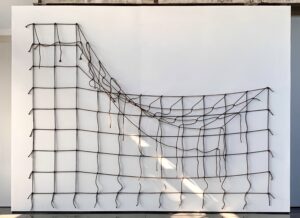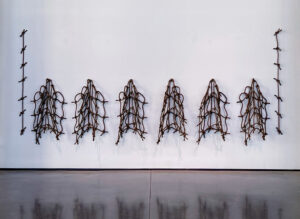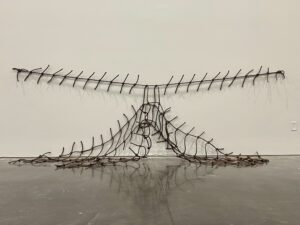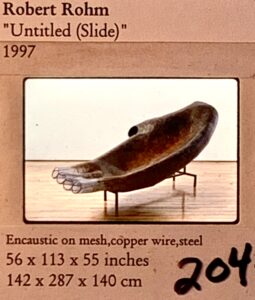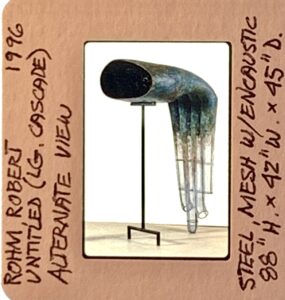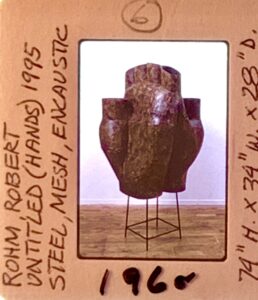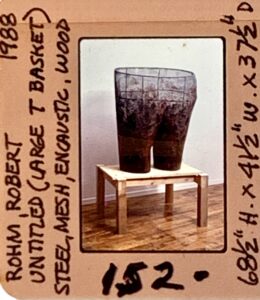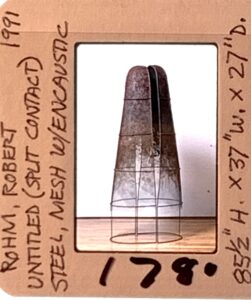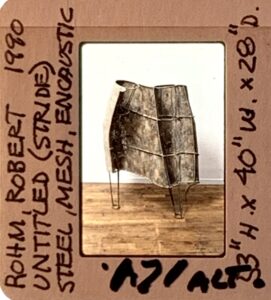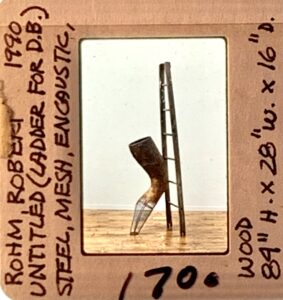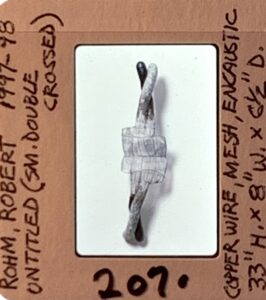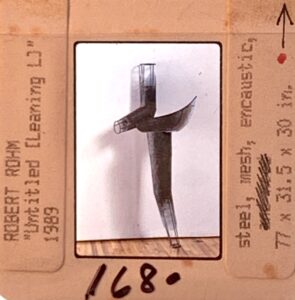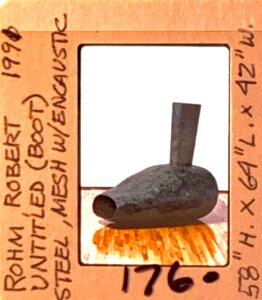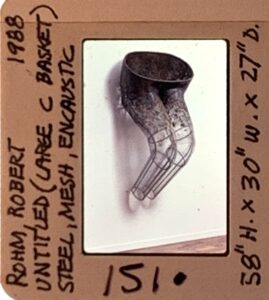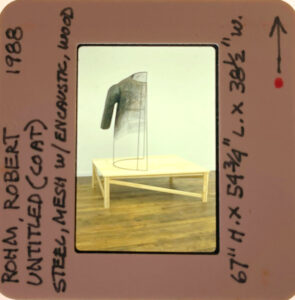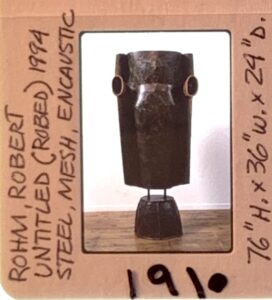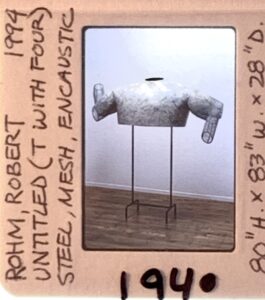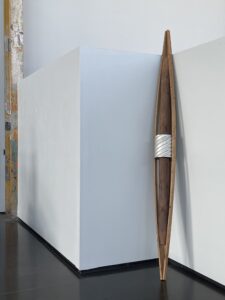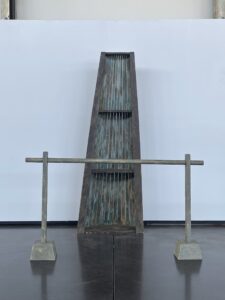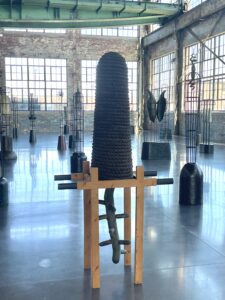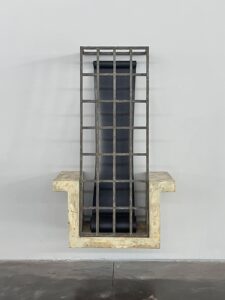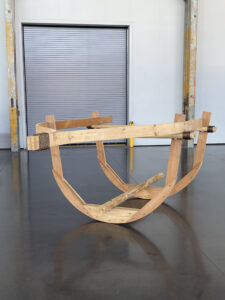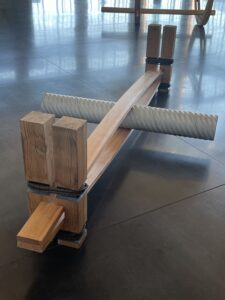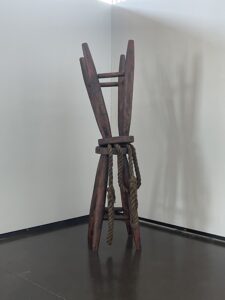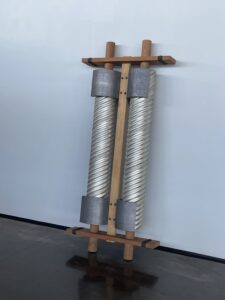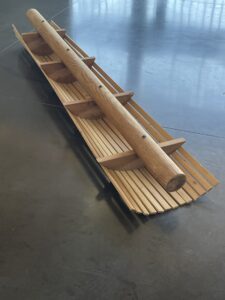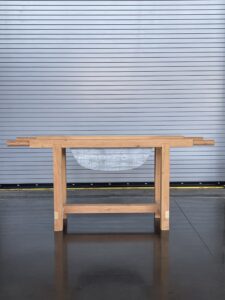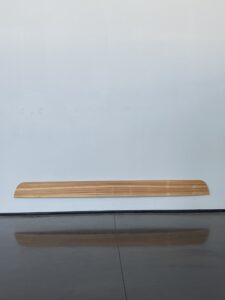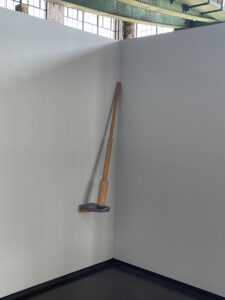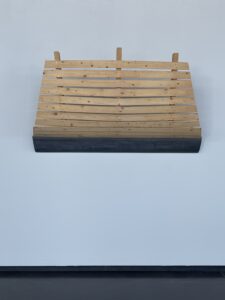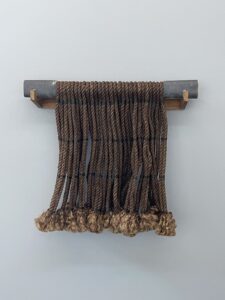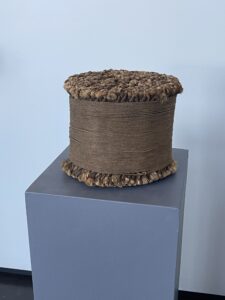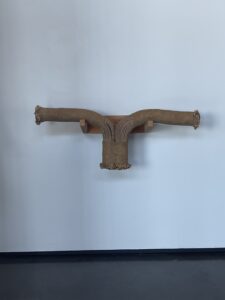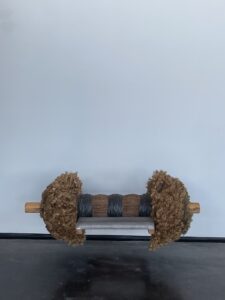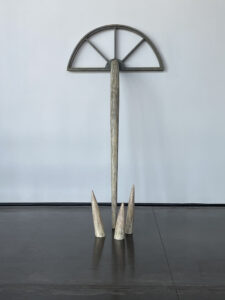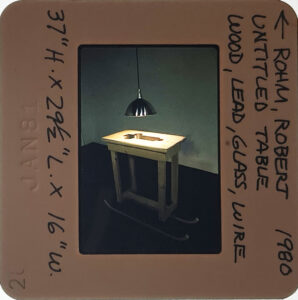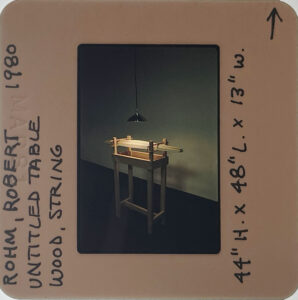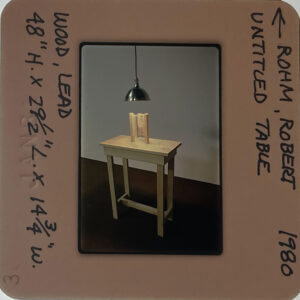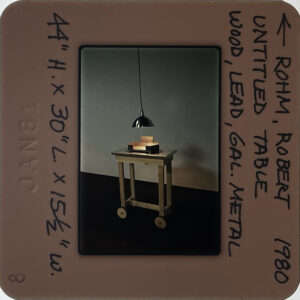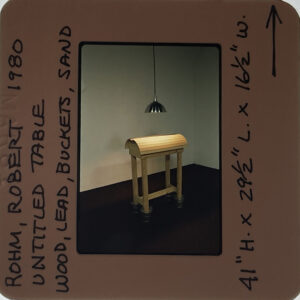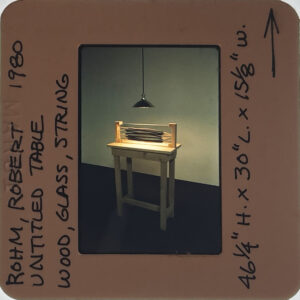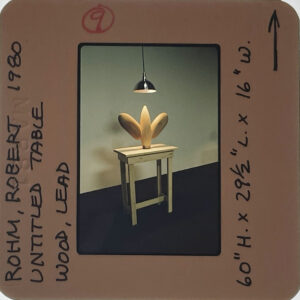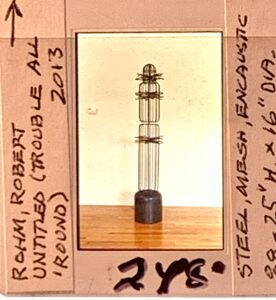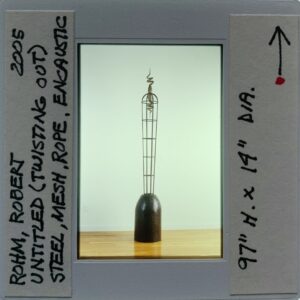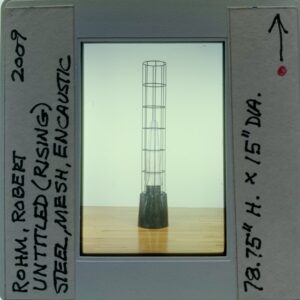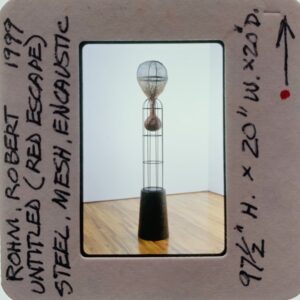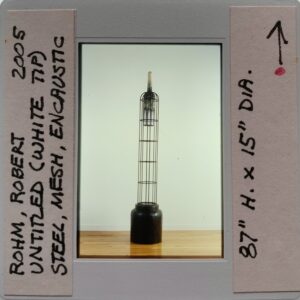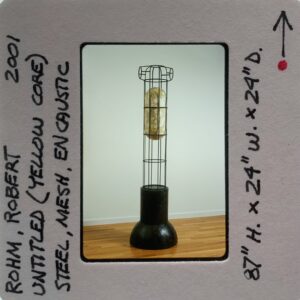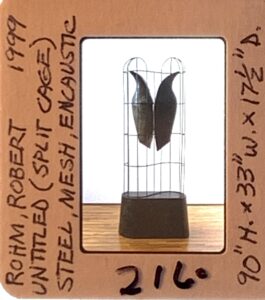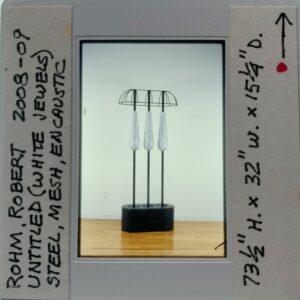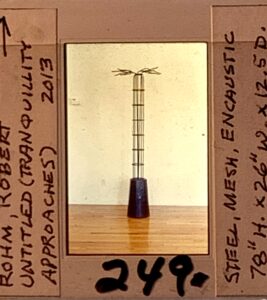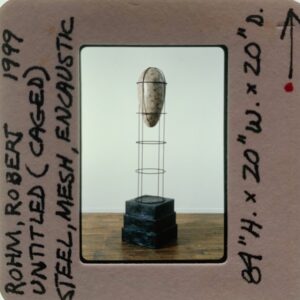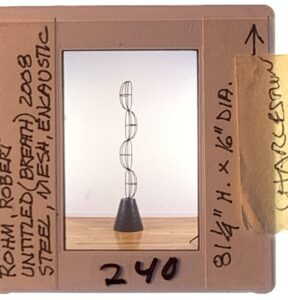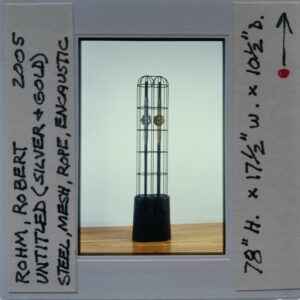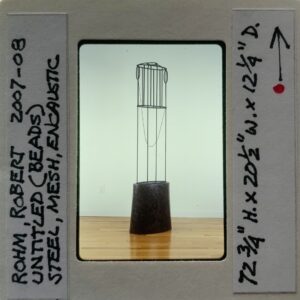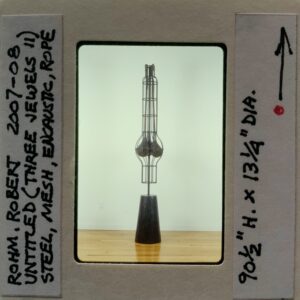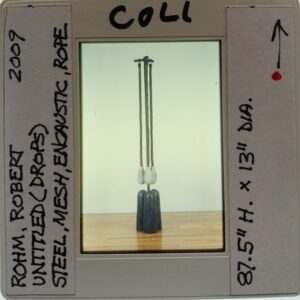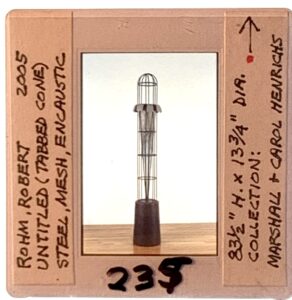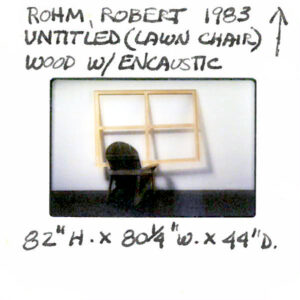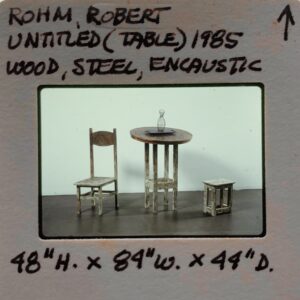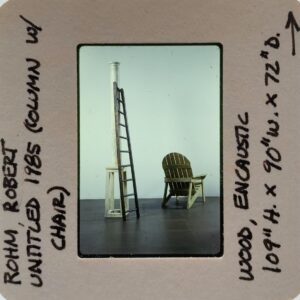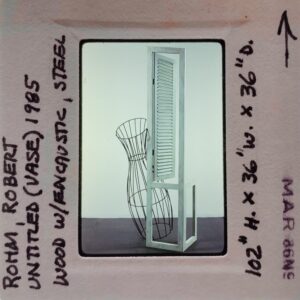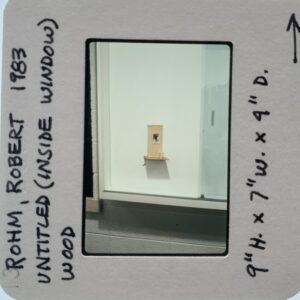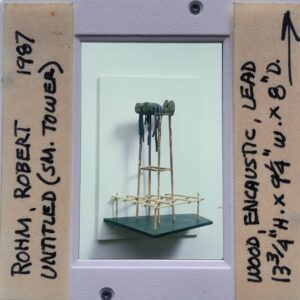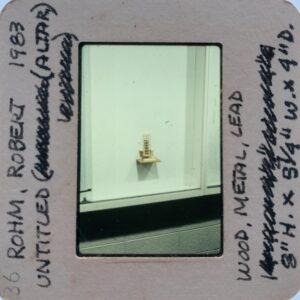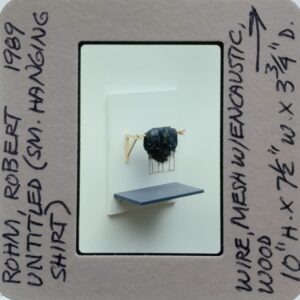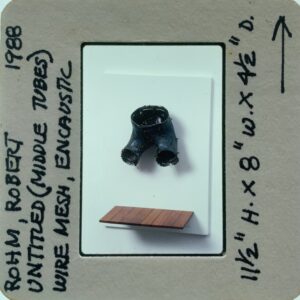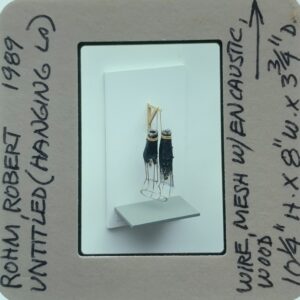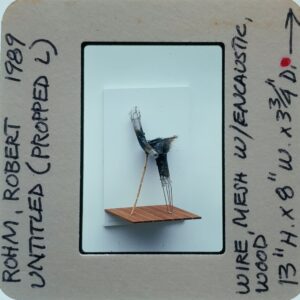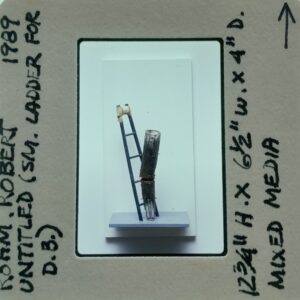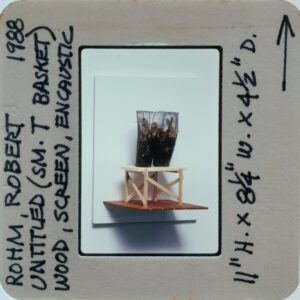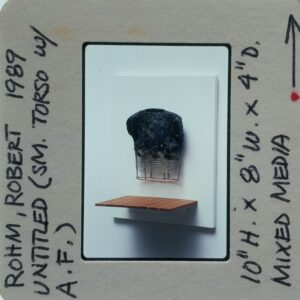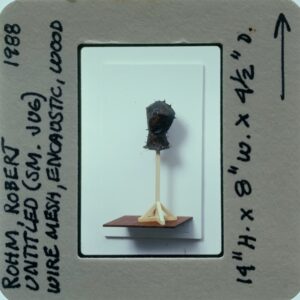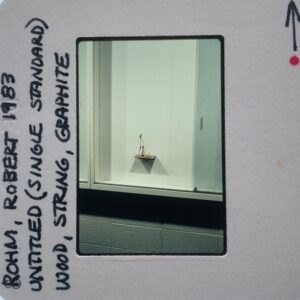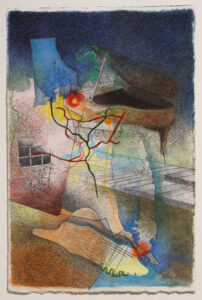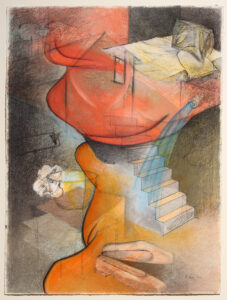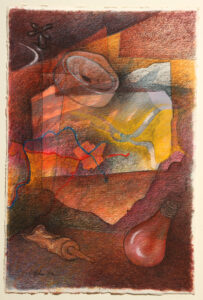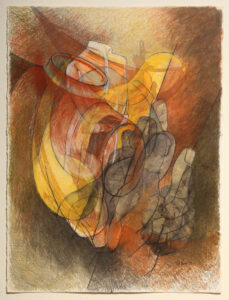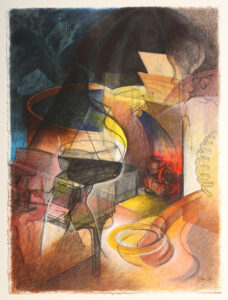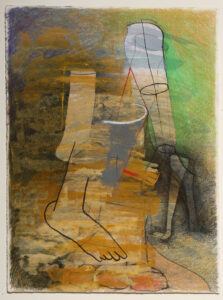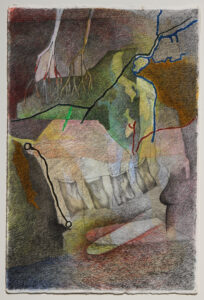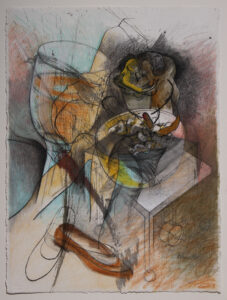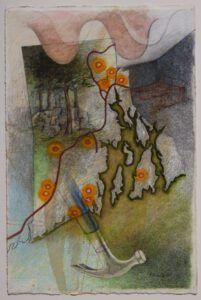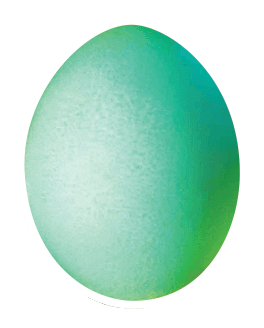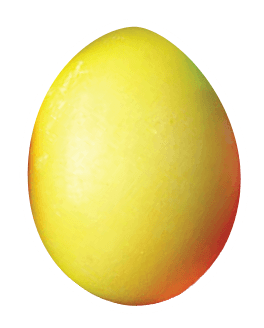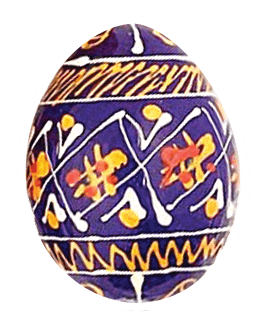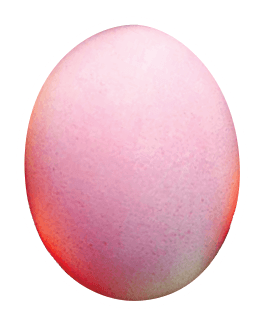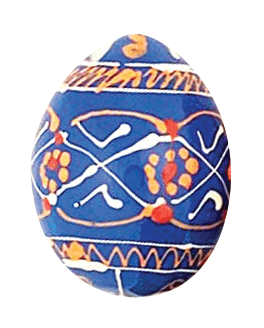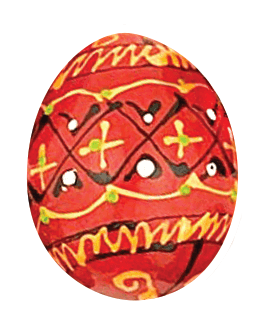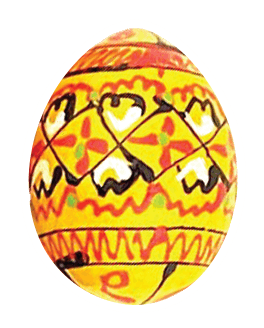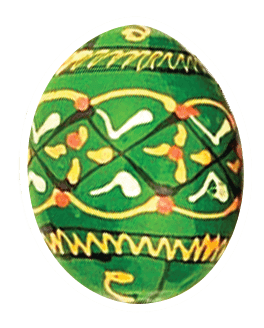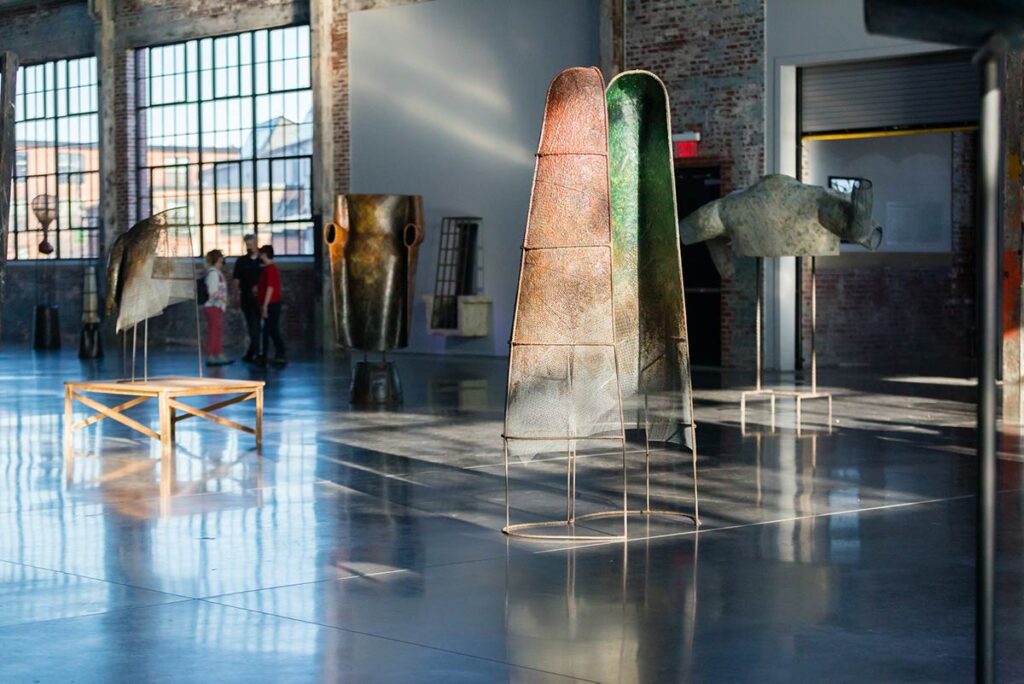
March 24 – April 25, 2021
WaterFire Arts Center
ABOUT THE WORK
ROPE GRIDS, 1969-1971 | ENCAUSTIC FIGURES, 1984-1997 | MATERIAL EXPERIMENTS, 1963-1984 | TABLES, 1980-1981 | COLUMNS, 1999-2013 | THEATRICAL SETS AND MAQUETTES | DRAWINGS | ESSAYS + REVIEWS | SIGN UP FOR MORE INFO
Robert Rohm is internationally recognized for his sculptures with exhibitions at the Whitney Museum of American Art; the Institute of Contemporary Art, Boston; the San Diego Museum of Contemporary Art; the Seattle Art Museum; and the Kunsthalle, Zurich, Switzerland. Rohm was a dedicated sculptor for fifty years as well as a professor of art at the University of Rhode Island for over thirty years. The exhibition chronicles Rohm’s aesthetic journey from his early abstract works in wood and his famous minimalist rope grids, through constructivist site works and performative theatrical sets, to spiritually-suffused work that re-materialized the human figure in a series of over-scale, calm, icon-like fragments, concluding with his final series of totemic columns. Rohm’s minimalist rope grids were featured in a series of ground-breaking exhibitions in the 1960s that established the “dematerialization of the art object” idea within conceptual art.
The exhibition was made possible by the support of Textron Charitable Trust, Cox Business, and Candy Adriance. It was organized by WaterFire Providence in collaboration with Candy Adriance. A special thanks to the Institute of Contemporary Art, Boston.
The artwork in the exhibition is still available for acquisition. For more information, please call the WaterFire Store.
All proceeds will go towards the WaterFire Providence Relief Fund and the Robert Rohm Art Scholarship Fund.
Rope Grids, 1969-1971
1
Untitled May 16th, 1969
1/2″ Manilla Rope stained brown
16′ H x 22′ W
Re-created 2021, in accordance with Rohm’s process and procedures. Installation instructions on paper on loan from the Institute of Contemporary Art, Boston. Gift of Candy Adriance.
2
Untitled 1969 (Six Clumps)
Rope stained brown
6′ H x 15′ 9″ W
Re-created 2021, in accordance with Rohm’s process and procedures. Installation instructions on paper on loan from the Institute of Contemporary Art, Boston. Gift of Candy Adriance.
3
Untitled March 8th, 1970 (Horizontal Center Hold)
Rope stained brown
15′ 6″ W
Re-created 2021, in accordance with Rohm’s process and procedures.
Encaustic Figures, 1984-1997
1
Untitled (Slide) 1997
Encaustic on Mesh, Copper, Wire, Steel
56″ H x 113″ W x 55″ D
2
Untitled (Large Cascade) 1996
Steel, Mesh, Encaustic
88″ H x 42″ W x 45″ D
3
Untitled (Hands) 1995
Steel, Mesh, Encaustic
74″ H x 34″ W x 28″ D
4
Untitled (Large T Basket) 1988
Steel, Mesh, Encaustic, Wood
68.5″ H x 41.5″ W x 37.5″ D
5
Untitled (Split Contact) 1991
Steel, Mesh, Encaustic
85.5″ H x 37″ W x 27″ D
6
Untitled (Stride) 1990
Steel, Mesh, Encaustic
53″ H x 40″ W x 28″ D
7
Untitled (Ladder for D.B.) 1990
Steel, Mesh, Encaustic, Wood
84″ H x 28″ W x 16″ D
8
Untitled (Small Double Crossed) 1997-98
Copper Wire, Mesh, Encaustic
33″ H x 8″ W x 6.5″ D
9
Untitled (Leaning L) 1989
Steel, Mesh, Encaustic
77″ H x 31.5″ W x 30″ D
10
Untitled (Boot) 1991
Steel, Mesh, Encaustic
58″ H x 64″ W x 42″ D
11
Untitled (Large C Basket) 1988
Steel, Mesh, Encaustic
58″ H x 30″ W x 27″ D
12
Untitled (Coat) 1988
Steel, Mesh, Encaustic
67″ H x 54.75″ W x 38.5″ D
13
Untitled (Robed) 1994
Steel, Mesh, Encaustic
76″ H x 36″ W x 24″ D
14
Untitled (T with Four) 1994
Steel, Mesh, Encaustic
80″ H x 83″ W x 28″ D
Material Experiments, 1963-1984
1
Untitled (Corner Bow) 1979
Wood, Aluminum Pipe
9’4″ H x 10.5″ D
2
Untitled (Barrier) 1984
Wood, Encaustic
80″ H X 62″ W X 72″ D
3
Untitled (Hive) 1983
Mixed Media
78″ H X 39″ W X 18″ D
4
Untitled (Altar) 1984
Wood, Encaustic, Rubber
65″ H X 39″ W X 19″ D
5
Untitled (Bow Section) 1979
Wood, Rope
60″ H X 168″ W X 90″ D
6
Untitled (Floor Bow) 1979
Wood, Aluminum Pipe, Lead, Rope
2′ 6″ H x 5′ 2″ W x 11′ D
7
Untitled (Stools) 1983
Wood, Encaustic, Rope
73″ H X 30″ W X 27″ D
8
Untitled (Leaning Double Tube) 1979
Wood, Aluminum Pipe, Lead, Cord
6′ 9″ H x 3′ W x 10″ D
9
Untitled (Floor Beam) 1979
Wood
8’4″ H x 2′ W x 1’2″ D
10
Untitled (Carrier) 1981
Wood, Lead, Glass, Coal
38″ H x 84″ W x 20.75″ D
11
Untitled (Wall Canoe) 1979
Wood
10″ H x 11′ W x 5.5″ D
12
Untitled (Leaning Tiered Pestle) 1979
Wood Lead
59″ H x 8″ W x 12″ D
13
Untitled (Wall Hull) 1979
Wood, Lead
41″ H x 60″ W x 19″ D
14
Untitled (Draped Bristles) 1977
Wood, Rope, Lead, Wire
19″ H x 24″ W x 4.25″ D
15
Untitled (Bound Ends) 1979
Rope, String
16″ H x 10.5″ W x 15″ D
16
Untitled
Wood, Rope, String
17
Untitled (Frizzled Ends) 1975
Wood, Rope, Lead, Rubber
20″ H x 38″ W x 27″ D
18
Untitled (Meteor) 1984
Wood, Encaustic
104″ H x 54″ W x 50″ D
Tables, 1980-1981
1
Untitled Table 1980
Wood, Glass, Lead, Wire
37″ H x 29 1/2″ L x 16″ W
2
Untitled Table 1980
Wood, String
44″ H x 48″ L x 13″ W
3
Untitled Table 1980
Wood, Lead
48″ H x 29 1/2″ L x 14 3/4″ W
4
Untitled Table 1980
Wood, Lead, Gal. Metal
44″ H X 30″ L X 15 1/2″ W
5
Untitled Table 1980
Wood, Lead, Buckets, Sand
41″ H x 29 1/2″ L x 16 1/2″ W
6
Untitled Table 1980
Wood, Glass, String
46 1/4″ H x 30″ L x 15 1/8″ W
7
Untitled Table 1980
Steel, Mesh, Encaustic
60″ H x 29 1/2″ L x 16″ W
Columns, 1999-2013
1
Untitled (Trouble All ‘Round) 2013
Steel, Mesh, Encaustic
88.25″ H x 16″ Dia
2
Untitled (Twisting Out) 2005
Steel, Mesh, Rope, Encaustic
97″ H X 14″ Dia
3
Untitled (Rising) 2009
Steel, Mesh, Encaustic
78.75″ H X 15″ Dia
4
Untitled (Red Escape) 1999
Steel, Mesh, Encaustic
97 1/2″ H X 20″ W X 20″ D
5
Untitled (White Tip) 2005
Steel, Mesh, Encaustic
87″ H X 15″ Dia
6
Untitled (Yellow Core) 2001
Steel, Mesh, Encaustic
87″ H x 24″ W x 24″ D
7
Untitled (Split Cage) 1999
Steel, Mesh, Encaustic
90″ H X 33″ W X 17 1/2″ D
8
Untitled (White Jewels) 2008-09
Steel, Mesh, Encaustic
73 1/2″ H x 32′ W x 15 1/4″ D
9
Untitled (Tranquillity Approaches) 2013
Steel, Mesh, Encaustic
78″ H x 26″ W x 12 1/2″ D
10
Untitled (Caged) 1999
Steel, Mesh, Encaustic
84″ H x 20″ W x 20″ D
11
Untitled (Breath) 2008
Steel, Mesh, Encaustic
81 1/4″ H x 16″ Dia
12
Untitled (Silver + Gold) 2005
Steel, Mesh, Rope, Encaustic
78″ H x 17 1/2″ W x 10 1/2″ D
13
Untitled (Beads) 2007-08
Steel, Mesh, Encaustic
72 3/4″ H x 20 1/2″ W x 12 1/4″ D
14
Untitled (Three Jewels II) 2007-08
Steel, Mesh, Encaustic, Rope
90 1/2″ H x 13 1/4″ Dia
15
Untitled (Drops) 2009
Steel, Mesh, Encaustic, Rope
87.5″ H x 13″ Dia
16
Untitled (Tabbed Cone) 2005
Steel, Mesh, Encaustic
83 1/2″ H x 13 3/4″ Dia
Theatrical Sets and Maquettes
1
Untitled (Lawn Chair) 1983
Wood W/Encaustic
82″ H x 80 1/4″ W x 44″ D
2
Untitled (Table) 1985
Wood, Steel, Encaustic
48″ H x 84″ W x 44″ D
3
Untitled (Column W/Chair) 1985
Wood, Encaustic
109″ H x 90″ W x 72″ D
4
Untitled (Vase) 1985
Wood W/Encaustic, Steel
102″ H x 36″ W x 36″ D
5
Untitled (Inside Window) 1984
Wood, Metal
11.5″ H x 9.25 W x 6.16″ D
6
Untitled (Sm. Tower) 1987
Wood, Encaustic, Lead
13.75″H x 9.25″W x 8″D
7
Untitled (Altar) 1983
Metal, Wood, Lead
14.5″ H x 8.25″ W x 6.25″ D
8
Untitled (Sm. Hanging Shirt) 1989
Wire, Mesh, Encaustic & Wood
12.25″ H x 9.75″ W x 6″ D
9
Untitled (Middle Tubes) 1989
Wire, Encaustic & Mesh
12.75″ H x 9.25″ W x 6″ D
10
Untitled (Hanging Ls) 1989
Wire, Mesh, Encaustic & Wood
15.25″ H x 9.25″ W x 6″ D
11
Untitled (Propped L) 1989
Wire, Mesh, Encaustic & Wood
15.25″ H x 10.25″ W x 6″ D
12
Untitled (Sm. Ladder for D.B.) 1989
Mixed Media
12.75″ H x 6.50″ W x 4″ D
13
Untitled (Sm. T Basket) 1988
Wood, Screen & Encaustic
11″ H x 8.25″ W x 4.5″ D
14
Untitled (Sm. Torso W/A.F.) 1989
Mixed Media
10″ H x 8″ W x 4″ D
15
Untitled (Sm. Jug) 1988
Wire Mesh, Encaustic, Wood
14″ H x 8″ W x 4.5″ D
16
Untitled (Single Standard) 1983
Wood, String, Graphite
Drawings
1
LB/TWO CHAIRS 2007
Oil pastel, wash, charcoal, and graphite on white wove paper
2
Untitled 1992
Oil pastel, wash, charcoal, and graphite on white wove paper
3
Untitled 1998
Oil pastel, wash, charcoal, and graphite on white wove paper
4
Untitled 1992
Oil pastel, wash, charcoal, and graphite on white wove paper
5
Untitled 1992
Oil pastel, wash, charcoal, and graphite on white wove paper
6
Untitled 1994
Oil pastel, wash, charcoal, and graphite on white wove paper
7
TWIGS 1998
Oil pastel, wash, charcoal, and graphite on white wove paper
8
Untitled 1992
Oil pastel, wash, charcoal, and graphite on white wove paper
9
LB/COT 2000
Oil pastel, wash, charcoal, and graphite on white wove paper
Essays + Reviews
Balance, Tension, and The Art of Robert Rohm
A review by Michael Rose. April 17, 2021.
READ REVIEW ON MICHAELROSEFINEART.COM
Sculptor Robert Rohm in Providence
A review by Cate Hewitt of The Connecticut Examiner. April 12, 2021.
READ REVIEW ON CTEXAMINER.COM
Physicality and Narrative in the Sculpture of Robert Rohm
In the late 1960’s a number of nationally known critics and curators described Robert Rohm’s sculpture as part of a cutting edge movement that denied metaphor and referential imagery. The Whitney Museum exhibition, “Anti-Illusion: Procedures / Materials” curated by Marcia Tucker and James Monte, defined Rohm and a group of his contemporaries including Carl Andre, Lynda Benglis, Philip Glass, Eva Hesse, Robert Morris and Richard Serra as seeking an art that largely set new terms for art making. The artists, from sculptors and painters, to musicians and filmmakers, depended on non-traditional materials, locations as a kind of armature, a multi-part, de-objectified sense of composition and time-based experiences that focused on an awareness of process and the activity of their own production.
Rohm’s early body of work was clearly part of this anti-illusionistic movement as it depended on the primacy of the physical materials themselves – that is the dimensions, weight, textures and shapes for his wood framing, corrugated metal, and industrial-grade rope. Rohm (and the other anti-illusionists) were not setting out to depict an a priori known reality but to ask questions of the materials and their settings. His early works were presented as a kind of empirical exploration of how the reality of physics affects the world around us all – as when a heavy hawser rope droops only so far between two supports, when pendulous weights hang within cage-like scaffolding, or the silvery corrugated surface of metal tubing contrasts with the matte finish of a wooden enclosure. This kind of physical reality is evident in an even earlier phase of his work – an organically shaped wooden sculpture by Rohm allows the bulbous arms of a massive carved wood beam to pivot around a large fulcrum point. In these anti-illusion works, industrial materials dominated but Rohm steadfastly refused to allude to any sense of storytelling beyond the realm of their physics – no harborside scenarios or construction sites are suggested by Rohm’s understated, matter-of-fact realism even though the materials might recall such places. The obstacle presence of his untitled rope works block us physically, just as his simple combinations of wood, lead and rope are barriers to specific references. In these earlier works (from about 1965 to 1980) he presents materials as facts rather than as occasions for narrative interpretation. These pieces, like Untitled (U-Support), 1975, confirm rather than merely re-present the real world.
Hints of narrative appeared by the end of the next decade when Rohm expanded the dimensions of his sculpture to become a kind of collaborative environment on which dancers could perform as in a series of large scale pieces produced between 1972 and 1978, the last of which was aptly titled Static/Dynamic. In a scaffolded structure which filled an experimental box theater space at the University of Rhode Island (where Rohm taught for over 3 decades), construction-grade materials became a landscape across which a performer could move and around which viewers could sit or stand. Not quite object sculptures, these were stage sets against which the abstracted motion of human activity is performed. No matter how rudimentary or pared down that movement might be, it connects these architectural scaled works with a strong sense of proto-narrative – we associate particular movements and poses with recognizable gestures, familiar habits or the relatable choreography of diachronic events. Rohm’s composition of sloped ramps, tubes and railings all provided occasions for some sequence of bio-physical movements that when added together begin to suggest the retelling of a story.
The possibility for such story-telling is even more evident in the next decade of work as Rohm develops set-like pieces which may have been inspired by some specific happening in the real world but which always make the narratives which inspired them implicit rather than explicit. In Untitled (Meteor Window), 1983, the tapered volume tracing an arc from the architectural form of mullioned lunette to the spiky blob on the floor might be interpreted as a graceful abstract gesture or a flowing liquid ending in a splash but part of its origins lie in a news article about a small meteor crashing through a New England house. Of course, the story is only a starting point as Rohm distills it to essential shapes and details so that it remains a kind of parsed narrative described by its most elemental forms. In Untitled (Lawn Chair) from the same year, one could read it as the scene of a leisurely contemplation of art or more metaphorically gazing at a landscape of nature through a paneless window frame. While the chair style suggests rustication and relaxation, the stretcher frame reads as something incomplete or past its usefulness. Notable too, the open framework rests directly on the arms of the Adirondack chair. Each of these pieces has a kind of built-in tension, between legibility and enigma (perhaps suggested early on by the bifurcated titles given each by Rohm, something untitled (unknown, unknowable) and something particular and familiar (meteor, window, chair). Rohm only gives us the most laconic set of clues, often tweaked just enough to imply another story, just beyond our ken.
By the end of the next decade, some of these proto-narrative props develop into a series that clearly references human body forms. Untitled (Torso), 1989, (Collection Newport Art Museum) reads like an enormous piece of clothing, a billowing tee-shirt form that retains the shape of a human torso. Another contemporary work, also constructed of steel frame and wax surface, Untitled (Hand), 1989, (Private Collection) presents a Buddha-like hand perhaps derived from the sculptural hands that are ofttimes hacked from sacred Asian sculptures and sold as discrete ethnographic objects. The forms here are clearly recognizable as a hand but one whose forms coincidentally reflect on sinuous gestural dance movements or even elephantine trunks both of which reinforce an Asian reference frame. These works are abstracted from real life scale and materials but manage to simultaneously convey figuration just as the earlier works grew out of narrative inspirations but denied ready interpretations. Balancing these dichotomies is at the core of Rohm’s artistic process.
Other influences appear in the 90’s and continue through the end of his career including Asian sources and biomorphic forms. These initial works of his later phase are informed by Rohm’s growing interest in a contemplative practice inspired by his Asian travels, and specifically to his encounters with a Buddhist monk in a monastery in Thailand. Returning there several times across a span of about two decades, Rohm’s subsequent sculpture shows a distinct shift in its formal arrangements – with attenuated forms often suspended in a linear frame of steel rebar. The elaboration of these decidedly vertical compositions into a bottom base, a rising shaft and some complexity of elements at the top, might initially suggest a reworking of an age-old architectural vocabulary based on columns and capitals. Another, perhaps more meaningful reference for this series might be the human body. The biomorphic, pendulous forms, often fabricated of wood, cloth and wax – are set within frameworks of skeletal cages with the solid elements suspended in the central core. These visually allude to erect human figures, with their height echoing Rohm’s own considerably lanky body type.
As Rohm aged, his work seems to turn inward for its inspiration – both biologically, in terms of the body, and spiritually, in terms of a meditative state. This may be why his career-long drawing practice, even noted in the early analysis of the Anti-Illusion catalog, continued uninterrupted in his later years. He intuitively may have realized that drawing, more than the constructive physicality of sculpture, allows for a quieter, contemplative and focused practice, prompting a mental dialogue with oneself. Rohm once spoke enthusiastically of his encounter with slow conscious walking as a path to gain insight into himself. Perhaps his drawings were a way to quietly discover the same insights in his art with a reflective studio practice.
One might be tempted to see this late phase as a reflection on Rohm’s health concerns in the last decade of his life but this ignores the evidence that referential elements are evident in much of his work and over several decades from the abstractly carved morphs of his early carved wood sculptures to the quotidian reality of the rope works, then the proto-narratives of his staged objects to the more interiorized presentations of his late works. Rohm’s sculpture always tells a story. At first it may have been the self-aware investigations of a young artist coming to an understanding of the most progressive art language of the 60’s and 70’s, then later retelling or presenting stories as experienced by others and finally, the gnomic self-presence of his more personal, anthropomorphic late works. His is an art that is always imbued with a sense of communication – exposing the physics of materiality in the early work, setting the stage for human action (either through dance or storytelling) in his mid-career and then returning to an inner, thoughtfulness as he reflects not just on art but on life itself.
Ronald J. Onorato
Chair and Professor of Art History
Department of Art & Art History
University of Rhode Island
2018
Untitled 1985 (If You Don’t Now, You’ll Never)
I recall first visiting Bob in his studio in 1983 on Lake Street in Wakefield, Rhode Island. We’d met earlier that year, and this was my first visit to his lair. Behind his home in a converted garage was Bob’s world of organized chaos; wax, pigment, wire armatures, wood. Welding devices, carpenter’s tools, source photographs pinned to the walls. The smell of pine sap, sweat, candles. And then, of course there were the arresting sculptures, some in various state of undress, and some meticulously complete.
Back in those days, Bob and I were both moving away from the pure abstraction and minimalism that defined the previous generation of artists and choreographers, and that still fascinated many of our peers.
We shared a voyeuristic interest in the domestic sphere. How everyday objects and day-to-day activities held nuggets of beauty, pain, connection, and despair.
During our meeting that day, a seed was planted. Bob and I would collaborate. We’d endeavor to create a performance experience that, while not necessarily a typical story with a beginning, middle, and end, was still quite definitely a journey through a domestic landscape. An experience filled with pleasures and landmines alike.
Over the course of the next year we worked in our separate spheres, touching base, sharing progress, making choices. Bob would visit my dance studio in Soho to watch rehearsals, always with a sly smile and a look of wonder in his eyes. Bob was not one to discuss the narrative content, or ‘meaning’ of his sculptures. He always wanted viewers to bring their own interpretations when viewing his work. But we did make some symbolic and literal choices in this collaboration. There are those vases, of course. A large one and a small one on a tray, both ancient symbols of femininity, of holding, of domesticity. There are those chairs and stools; places to rest, or maybe instead to be held against one’s will. And then, the window and shutter; defining interior spaces and alluding to unreachable possibilities in a world beyond.
Bob’s sculptures of this period resonate with implications. These evocative beauties with their ghostly messages, skewed perspectives and wily humor inspired me to do the best choreographic work of my career.
Alice Kaltman
March 2021
Down to Earth: Robert Rohm Sculpture, 1963-2013 will run March 24 – April 25, 2021. The exhibit is free for all, donations encouraged. The WaterFire Arts Center hours are: Wednesday – Sunday, 10:00 a.m.- 5:00 p.m, Thursday 10:00 a.m. – 8:00 p.m. All visitors are required to self screen before entering the WaterFire Arts Center and practice safety rules: keeping a 6’ distance from others and wear a mask at all times.
